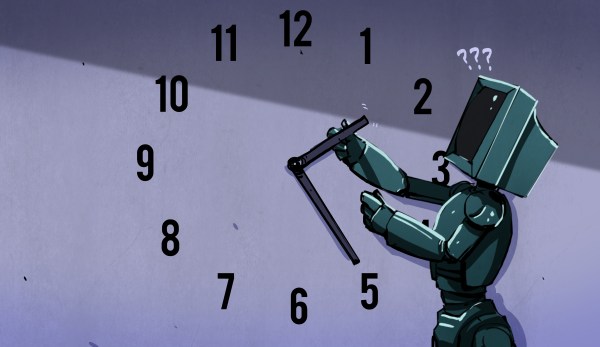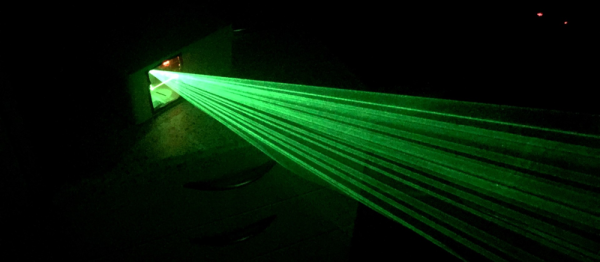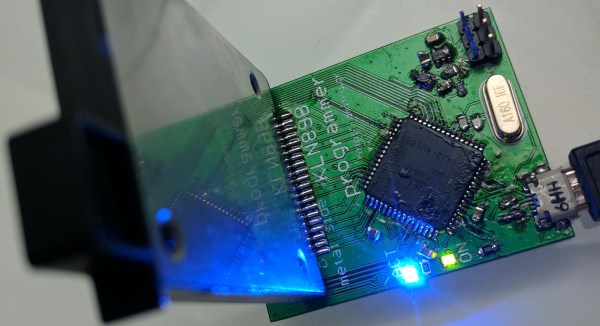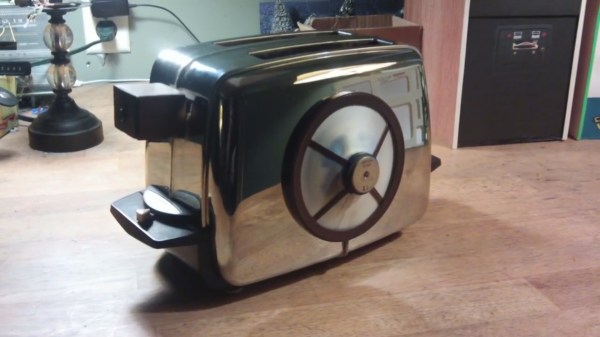We recently went through our twice yearly period of communal venting called adjusting for daylight saving time (DST), or British Summer Time (BST) as it’s called in the UK. But why are we changing the time? Seriously, who caused all this? Does it do any good? Do we still need it? And what can we do about it? As it turns out, most of us want it, as you’ll see below.
Author: Steven Dufresne295 Articles
Cheap Dual Mirror Laser Projector
[Stanley] wanted to make a laser projector but all he could find online were one’s using expensive galvanometer scanners. So instead he came up with his own solution that is to be admired for its simplicity and its adaptation of what he could find.
At its heart is an Arduino Uno and an Adafruit Motor Shield v2. The green laser is turned on and off by the Arduino through a transistor. But the part that makes this really a fun machine to watch at work are the two stepper motors and two mirrors that reflect the laser in the X and Y directions. The mirrors are rectangles cut from a hard disk platter, which if you’ve ever seen one, is very reflective. The servos tilt the mirrors at high speed, fast enough to make the resulting projection on the wall appear almost a solid shape, depending on the image.
He’s even written a Windows application (in C#) for remotely controlling the projector through bluetooth. From its interface you can select from around sixteen predefined shapes, including a what looks like a cat head, a heart, a person and various geometric objects and line configurations.
There is a sort of curving of the lines wherever the image consists of two lines forming an angle, as if the steppers are having trouble with momentum, but that’s probably to be expected given that they’re steppers controlling relatively large mirrors. Or maybe it’s due to twist in the connection between motor shaft and mirror? Check out the video after the break and let us know what you think.
Custom Data Writer Board For 1996 Plane’s GPS
[Dmitry Grinberg] recently bought a Cessna 150 that contained an old IFR-certified GPS from 1996, the KLN89B. The GPS unit contains a database which by law has to be kept up-to-date for IFR flight. The problem was that, while Honeywell still supplied the data in electronic form, [Dmitry] had no way to update the GPS. The original ways for doing it are either no longer supported, too expensive and a pain to do, or not available to him due to the way his GPS was installed.
Two of those ways involved removing a data card which can legally be slid out of the GPS’s front panel. The data card is what stores all the data but it’s a proprietary card and there’s no reader for it. [Dmitry]’s solution was therefore to make his own reader/writer board.
Continue reading “Custom Data Writer Board For 1996 Plane’s GPS”
Red Dwarf’s Talkie Toaster Tests Tolerance
In the Red Dwarf TV series, Talkie Toaster wants to know if you want toast, and if not toast, then maybe a muffin or waffle, and it will pester you incessantly until you smash it with a 14lb lump hammer and throw it in a waste disposal. Now [slider2732] has actually gone and made one of the infernal machines!
He’s hidden a PIR sensor in the toaster handle to tell an Arduino Pro Mini when someone is unfortunate enough to be passing by. The Arduino then reads sound files from an SD card reader and plays them through a 3 watt amplifier out to a speaker. For that he uses the TMRpcm library available on github.
[slider2732] cleverly mounted the speaker to the side of the toaster along with some appropriately shaped bits and pieces, and some LEDs to make it appear and work much like the circular panel that lights up on the real Talkie Toaster. We dare you to watch the video after the break, unless you really are looking for toast. As a consolation, the video also walks through making it.
Continue reading “Red Dwarf’s Talkie Toaster Tests Tolerance”
Raspberry Pi Robot That Reads Your Emotions
It’s getting easier and easier to add machine intelligence to your hacks, even to the point where you sometimes don’t have to install any special software. In this case [Dexter Industries] has added the ability to read human emotions to their EmpathyBot robot by making use of Google Cloud Vision.
Press a button on the robot and it moves forward until it’s a certain distance from an object. It then takes a picture and sends it off to Google Cloud Vision along with a request to do face detection. The response that Google returns is in JSON format and, if it finds a face, includes the likelihood of the face being happy, sad, sorrowful or surprised. The robot parses that response and gives an appropriate canned speech using the text-to-speech software, eSpeak e.g. “You seem happy! Tell me why you are so happy!”.
[Dexter] has made the source code available on github. It’s written in python and is easy to read by anyone with even just a little programming experience. The video after the break gives a number of demonstrations, including some with non-human subjects.
Continue reading “Raspberry Pi Robot That Reads Your Emotions”
Power Wheels Rescued, Restored And Enhanced
It seems power wheels are like LEGO — they’re handed down from generation to generation. [Nicolas] received his brand-new Peg-Perego Montana power wheels in 1997 as a Christmas present. After sitting in a barn for a decade, and even being involved in a flood, it was time to give it to his godchildren, though not without some restoration and added features. His webpages have a very good write-up, just shy of including schematics, but you’ll find an abbreviated version below.
Continue reading “Power Wheels Rescued, Restored And Enhanced”
Ask Hackaday: How Do You Convert Negative Voltages To Positive?
I have a good background working with high voltage, which for me means over 10,000 volts, but I have many gaps when it comes to the lower voltage realm in which RC control boards and H-bridges live. When working on my first real robot, a BB-8 droid, I stumbled when designing a board to convert varying polarities from an RC receiver board into positive voltages only for an Arduino.
Today’s question is, how do you convert a negative voltage into a positive one?
In the end I came up with something that works, but I’m sure there’s a more elegant solution, and perhaps an obvious one to those more skilled in this low voltage realm. What follows is my journey to come up with this board. What I have works, but it still nibbles at my brain and I’d love to see the Hackaday community’s skill and experience applied to this simple yet perplexing design challenge.
The Problem
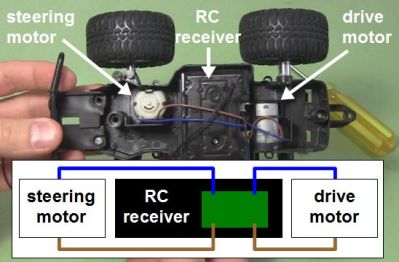
I have an RC receiver that I’ve taken from a toy truck. When it was in the truck, it controlled two DC motors: one for driving backwards and forwards, and the other for steering left and right. That means the motors are told to rotate either clockwise or counterclockwise as needed. To make a DC motor rotate in one direction you connect the two wires one way, and to make it rotate in the other direction you reverse the two wires, or you reverse the polarity. None of the output wires are common inside the RC receiver, something I discovered the hard way as you’ll see below.
Continue reading “Ask Hackaday: How Do You Convert Negative Voltages To Positive?”

